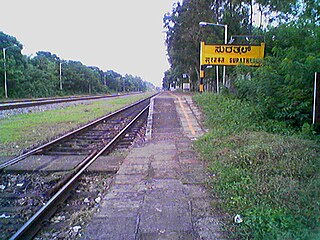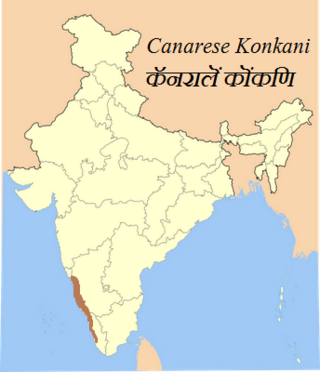
Kundapra, officially Kundapura, is a town in the Udupi district of Karnataka state in India. This town was known as Coondapoor when it was part of the erstwhile South Canara district (1862–1947) of the Madras Presidency of British India. Present-day Kundapur is administered by the Kundapur Town Municipal Council and serves as the headquarters of eponymous Kundapur taluk in Udupi district.

Dakshina Kannada district is located in the state of Karnataka in India, with its headquarters in the coastal city of Mangalore. The district covers an area nestled in between the Western Ghats to its east and the Arabian Sea to its west. Dakshina Kannada receives abundant rainfall during the Indian monsoon. It is bordered by Udupi district to the north, Chikmagalur district to the northeast, Hassan district to the east, Kodagu to the southeast and Kasaragod district of Kerala to the south. According to the 2011 census of India, Dakshina Kannada district had a population of 2,083,625. It is the only district in Karnataka state to have all modes of transport like road, rail, water and air due to the presence of a major hub, Mangalore. This financial district is also known as the Cradle of Indian banking.

Yakshagana is a traditional theatre, developed in Dakshina Kannada, Udupi, Uttara Kannada, Shimoga and western parts of Chikmagalur districts, in the state of Karnataka and in Kasaragod district in Kerala that combines dance, music, dialogue, costume, make-up, and stage techniques with a unique style and form. It is believed to have evolved from pre-classical music and theatre during the period of the Bhakti movement. It is sometimes simply called "Aata" or āṭa. This theatre style is mainly found in coastal regions of Karnataka in various forms. Towards the south from Dakshina Kannada to Kasaragod of Tulu Nadu region, the form of Yakshagana is called Thenku thittu and towards the north from Udupi up to Uttara Kannada it is called Badaga thittu. Both of these forms are equally played all over the region. Yakshagana is traditionally presented from dusk to dawn. Its stories are drawn from Ramayana, Mahabharata, Bhagavata and other epics from both Hindu and Jain and other ancient Indic traditions.

Kota Shivaram Karanth, also abbreviated as K. Shivaram Karanth, was an Indian polymath, who was a novelist in Kannada language, playwright and an ecological conservationist. Ramachandra Guha called him the "Rabindranath Tagore of Modern India, who has been one of the finest novelists-activists since independence". He was the third writer to be decorated with the Jnanpith Award for Kannada, the highest literary honor conferred in India. His son Ullas is an ecological conservationist.
Saraswat Brahmins are spread over widely separated regions spanning from Kashmir and Punjab in North India to Konkan in West India to Kanara and Kerala in South India. In places such as western and southern India, the claim of Brahminhood of some communities who claim to be Saraswat Brahmins is disputed. The word Saraswat is derived from the Rigvedic Sarasvati River.
Mallya is a surname from coastal Karnataka in India. It is found among Hindus of the Goud Saraswat Brahmin community, especially of Madhva Section following Gokarna Math and Kashi Math.
Kamat or Kamat is a surname from Goa, Maharashtra and coastal Karnataka in India. It is found among Hindus of the Goud Saraswat Brahmin, Saraswat and Rajapur Saraswat Brahmin communities following Madhva Sampradaya of either Gokarna Matha or Kashi Matha.

Shirali is a village in Bhatkal taluk of Uttara Kannada district in Karnataka. Shirali is home to two prominent temples: the Chitrapur Math and the Maha Ganapathi Mahammaya Temple. The Chitrapur Math is the holiest temple of the Chitrapur Saraswat Brahmin community, and the Maha Ganapathi Mahammaya temple is the Kuladev to the Kamaths, Bhats, Puraniks, Prabhus, Joishys, Mallyas, Kudvas and Nayak families from the Goud Saraswat Brahmin community.

Surathkal is one of the major localities in the northern part of Mangalore taluk located on National Highway 66 in the Dakshina Kannada district, Karnataka state, India on the shore of Arabian sea. It is a municipality merged with Mangalore City Corporation. It lies between Gurupura (Phalguni) and Pavanje (Nandini) rivers. It is the northern suburb and can be considered as the northernmost area of Mangalore City until Mukka. Surathkal has a railway station on Konkan railway route which connects cities of Mumbai to Mangaluru. Surathkal is 8 km north of New Mangalore seaport, 4 km west of Mangalore Refinery and Petrochemicals Limited and 16 km west of Mangalore International Airport This region has developed educationally, industrially and commercially can be regarded as one of the crucial localities in Mangaluru and coastal Karnataka. The only NIT of Karnataka is situated here which is adjacent to the national highway NH 66. Mukka a popular name in Indian surfing is also situated close to Surathkal. Surathkal beach is well known for its cleanliness and well maintained like other beaches in Mangalore.

Udupi district is an administrative subdivision in the Karnataka state of India, with the district headquarters in the city of Udupi. It is situated in the Canara old north Malabar coastal region. There are seven taluks, 233 villages and 21 towns in Udupi district. The three northern tehsils of Udupi, Kundapur and Karkala, were partitioned from Dakshina Kannada district to form Udupi district on 25 August 1997. Moodabidri was officially declared as new tehsil (taluk) in 2018.
Baliga is a Konkani Brahmin surname from Goa, coastal Karnataka and parts of Maharashtra, India. It is found among Hindus of the Goud Saraswat Brahmin community.
Gaud Saraswat Brahmins (GSB), also known as Shenvis are a Hindu community of contested caste status and identity. They primarily speak Konkani and its various dialects as their mother tongue.
Gangolli is a village in Kundapur Taluk of Udupi district in Karnataka state. It is situated at the estuary of the Panchagangavalli River. It is located on a peninsula on the west coast of Karnataka. It is bordered by the river to the east and by the Arabian Sea to the west.
Temples of the Indian State of Karnataka illustrate the variety of architecture prevalent in various periods. The architectural designs have found a distinguished place in forming a true atmosphere of devotion for spiritual attainment.
Mangaloreans are a collection of diverse ethnic groups that hail from the historical locales of South Canara (Tulunaad) on the south western coast of Karnataka, India, particularly the residents native to Mangaluru.

Karkala is a town and the headquarters of eponymous Karkala taluk in the Udupi district of Karnataka state in India. It lies near the foothills of the Western Ghats, Karkala has a number of natural and historical landmarks, and is a major tourist and transit destination due to its strategic location along the way to Hebri, Sringeri, Kalasa, Horanadu, Udupi, Kollur, Subrahmanya and Dharmasthala.
Tallur is a village in the Kundapur taluk of Udupi district in Karnataka State of India. It is less than five kilometres from the town of Kundapura.

Canarese Konkani are a set of dialects spoken by minority Konkani people of the Canara sub-region of Karnataka, and also in Kassergode of Kerala that was part of South Canara.
Halady, also spelled Haladi, is a small village located in Kundapura Taluk, Udupi District, Karnataka, 22 km from Taluk Centre Kundapura. Halady village consists of Halady 76 and Halady 28, which are two portions of the village.
Ampar is a village located in the Kundapur taluk of Udupi district in the Indian state of Karnataka.










